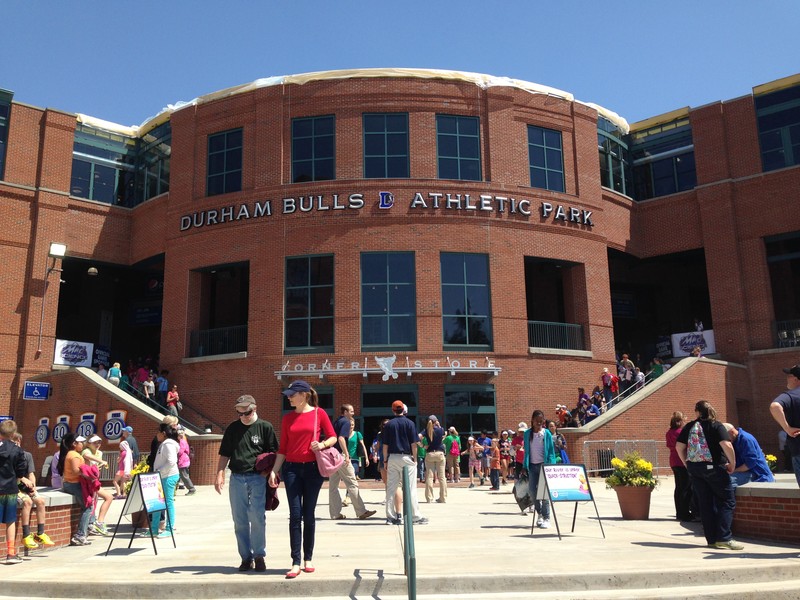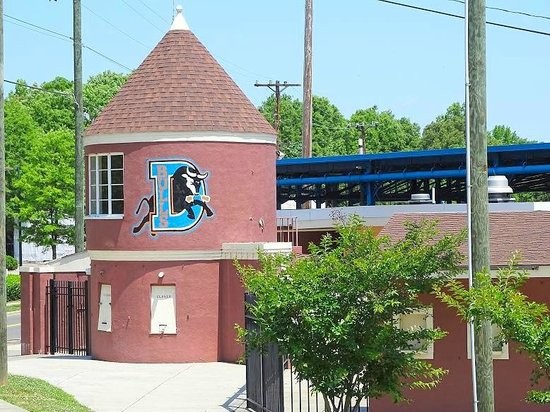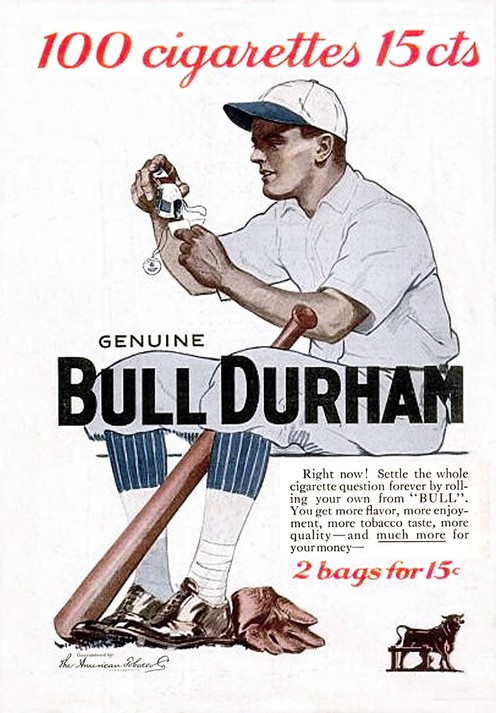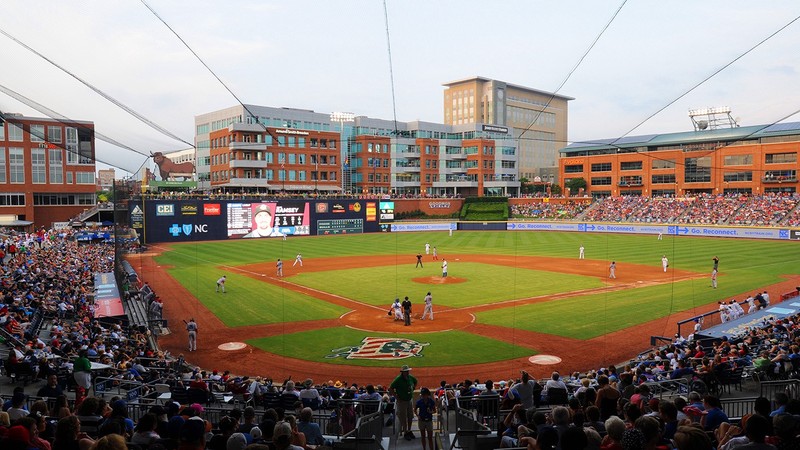Durham Bulls Athletic Park
Introduction
Text-to-speech Audio
Images
Durham Bulls Athletic Park - Exterior

Durham Athletic Park

Bull Durham Tobacco Ad

Durham Bulls Athletic Park

Backstory and Context
Text-to-speech Audio
In 1995, the Durham Bulls Athletic Park (DBAP) moved from its original location to its new American Tobacco District location in downtown Durham. The Durham Bulls initially played ball at the East Durham Ballpark in 1913 as a class D farm team for the Cincinnati Reds. World War I provided a temporary cease in play for the Bulls. However, in 1918, the Bulls joined the Piedmont League and began to gain more popularity. Over $160,000 in private funds were raised to construct a new ballpark, coined the “El Toro Ballpark.” The Bulls played their first game in the new location on July 7, 1926. Shortly thereafter, the park was officially dedicated to the Durham Bulls with both North Carolina governor Angus McLean and William Branam, the president of the National Association of Professional Baseball Leagues present. The Bulls won the Piedmont League in 1930 and in 1932 they became a farm team for the Philadelphia Phillies.
In 1939, the wooden stands of the El Toro Ballpark burned down. The city quickly hired George Watts Carr to reconstruct and design a new stadium. Following completion of the new stadium, equipped with metal and steel infrastructure rather than wood, the stadium was dubbed the “Durham Athletic Park.” Shortly thereafter, the Bulls switched ownership and became associated with the Brookly Dodgers major league team in 1940. They again switched affiliations in 1945 and 1948 with the Red Sox and the Detroit Tigers, respectively.
Interest in baseball dipped between the 1950s and 1960s, with attendance and profits hitting an all time low for the Durham Bulls. Ultimately, the Bulls were forced to merge with Raleigh’s baseball team and become the “Raleigh-Durham Mets.” The Raleigh-Durham Mets split time between their two stadiums, which afforded Durham High School the opportunity to use the Durham Athletic Park for football practice and other recreational activities. Every Friday, students of the Durham High School would hold a parade that ended at the Durham Athletic Park. Further, the Durham Athletic Park was the site of the anti-poverty march in May of 1968, with full crowds filling the stadium space.
In 1971, still called the Raleigh-Durham "Triangles," the Bulls dismantled and no baseball was played in Durham until 1981. The Durham Bulls emerged once again, with the film Bull Durham helping the team gain more popularity than ever in 1988. However, the Durham Athletic Park, featured in the film, was deteriorating and many fans, players, and coaches called for an upgraded facility. Despite some location related investor conflicts, the city opted to proceed with building a new, upgraded facility located in the American Tobacco District.
In 1995, the new Durham Bulls Athletic Park was built and established as the new home stadium for the Bulls. The new park was built to Triple A baseball park standards. The Durham Bulls eventually became an international level farm team for the Tampa Bay Rays. In 2013, the park underwent another upgrade complete with a seat expansion, an upgraded sound system, a childrens’ playground, and an expanded open air area to eat, drink, and socialize. The new ballpark is still rich with history, equipped with a view of revitalized tobacco trade buildings and warehouses on the third base side. Another attraction the new park boasts is the “Snorting Bull.” The Snorting Bull is located on what is known as the “Blue Monster” wall in left field. If a batter clears this wall or any other outfield fence, the bull celebrates the home run by blowing smoke out of its nostrils, lighting up, and wagging its tail -- a fan favorite. Another tradition associated with the bull is “hit the bull, win a steak.” The tradition is that if a home team player hits the actual bull, they win a steak from the Angus Barn Restaurant.
Sources
Kueber, Gary. DURHAM ATHLETIC PARK, Durham Athletic Park | Open Durham. January 1st 2008. Accessed November 10th 2019. http://www.opendurham.org/buildings/durham-athletic-park.
Palumbo, Andrew. Everything You've Ever Wanted To Know About The Durham Bulls Athletic Park, My NC Homes. August 6th 2016. Accessed November 10th 2019. https://www.mynchomes.com/blog/everything-youve-ever-wanted-to-know-about-the-durham-bulls-athletic-park.html.
. Durham Bulls Athletic Park, Museum of Durham History. Accessed November 10th 2019. http://museumofdurhamhistory.org/beneathourfeet/landmarks/DurhamBullsAthleticPark.
North Carolina History Project. Bull Durham Tobacco & the Durham Bulls , North Carolina History. Accessed November 10th 2019. http://northcarolinahistory.org/encyclopedia/bull-durham-tobacco-the-durham-bulls/.
Bull Durham. Shelton, Ronald. Performed by Susan Sarandon, Kevin Costner, Tim Robbins. USA. Orion Pictures, 1988.
https://en.wikipedia.org/wiki/Durham_Bulls_Athletic_Park
https://www.tripadvisor.com/LocationPhotoDirectLink-g49092-d6678293-i101275597-Historic_Durham_Athletic_Park-Durham_North_Carolina.html
https://www.flickr.com/photos/clotho98/6228954816
https://elgl.org/durham-bulls-game-at-elgl19/
